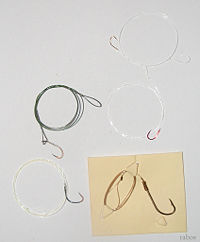Fishing line
| fishing |
|---|
| fishing line |
| braided |
| monofilament |
| multifilament |
| power pro |
| knots |
|
|
| tackle |
| recreational |
A Fishing line is any cord made for fishing. Important parameters of a fishing line are its length, material, and weight (thicker, sturdier lines are more visible to fish). Factors that may determine what line an angler chooses for a given fishing environment include breaking strength, knot strength, UV resistance, castability, limpness, stretch, abrasion resistance, and visibility.
Terminology
Fish are caught with a fishing line by encouraging a fish to bite upon a fish hook. A fishing hook will pierce the mouthparts of a fish and may be barbed to make escape less likely. Another method is to use a gorge, which is buried in the bait such that it would be swallowed end first. The tightening of the line would fix it cross-wise in the quarry's stomach or gullet and so the capture would be assured.
Fishing with a hook and line is called angling. In addition to the use of the hook and line used to catch a fish, a heavy fish may be landed by using a landing net or a hooked pole called a gaff.
Trolling is a technique in which a fishing lure on a line is drawn through the water. Trolling from a moving boat is a technique of big-game fishing and is used when fishing from boats to catch large open-water species such as tuna and marlin. Trolling is also a freshwater angling technique most often used to catch trout. Trolling is also an effective way to catch northern pike in the great lakes. It's also good for muskellunge in deeper lake using large baits also known as crankbaits or other big baits using strong line. This technique allows anglers to cover a large body of water in a short time.
Long-line fishing is a commercial fishing technique that uses hundreds or even thousands of baited hooks hanging from a single line.
Snagging is a technique where the object is to hook the fish in the body. Generally, a large treble hook with a heavy sinker is cast into a river containing a large amount of fish, such as a Salmon, and is quickly jerked and reeled in. Due to the often illegal nature of this method some practitioners have added methods to disguise the practice, such as adding bait or reducing the jerking motion.
Early developments
Fishing lines were often constructed from horse hair or silk thread, with catgut leaders. From the 1850s, modern industrial machinery was employed to fashion fishing lines in quantity. Most of these lines were made from linen, silk, and more rarely cotton or flax, sometimes with a waterproofing compound added during line manufacture.[1]
Modern lines
Modern fishing lines intended for spinning, spin cast, or bait casting reels are almost entirely made from artificial substances, including nylon, polyethylene, Dacron and Dyneema (UHMWPE). The most common type is monofilament, made of a single strand. Recently, other alternatives to standard nylon monofilament lines have been introduced made of copolymers or fluorocarbon, or a combination of the two materials. Flurocarbon in particular is well regarded for its refractive index, which is similar to that of water and as a result less visible to fish. There are also braided fishing lines, cofilament and thermally fused lines, also known as 'superlines' for their small diameter, lack of stretch, and great strength relative to standard nylon monofilament lines. Both braided and thermally fused 'superlines' are now readily available.
Specialty lines
Fly lines consist of a tough braided or monofilament core, wrapped in a thick waterproof plastic sheath, often of polyvinyl chloride (PVC). In the case of floating fly lines, the PVC sheath is usually imbedded with many 'microballoons' or air bubbles, and may also be impregnated with silicone or other lubricants to give buoyancy and reduce wear. In order to fill up the reel spool and ensure an adequate reserve in case of a run by a powerful fish, fly lines are usually attached to a secondary line at the butt section, called backing. Fly line backing is usually composed of braided dacron or gelspun monofilaments. All fly lines are equipped with a leader of monofilament or fluorocarbon fishing line, usually (but not always) tapered in diameter, and referred to by the 'X-size' (0X, 2X, 4X, etc.) of its final tip section, or tippet.
Wire lines are frequently used as leaders to prevent the fishing line from being severed by toothy fish. Usually braided from several metal strands, wire lines may be made of stainless steel, titanium, or a combination of metal alloys.
See also
- Braided fishing line
- Fishing
- Fish hook
- Fluorocarbon
- Fly fishing
- Monofilament line
- Multifilament fishing line
ReferencesISBN links support NWE through referral fees
- ↑ Henshall, James (Dr.), Book of the Black Bass (1881)
- Henshall, James (Dr.), Book of the Black Bass (1881)
- Largemouth Bass Fishing Tips Online Choosing The Right Fishing Line article
- Fishing Line A Guide to Fishing Line article
| ||||||||||||||||||||||||||||||||||||||||||||||||||||||||
Credits
New World Encyclopedia writers and editors rewrote and completed the Wikipedia article in accordance with New World Encyclopedia standards. This article abides by terms of the Creative Commons CC-by-sa 3.0 License (CC-by-sa), which may be used and disseminated with proper attribution. Credit is due under the terms of this license that can reference both the New World Encyclopedia contributors and the selfless volunteer contributors of the Wikimedia Foundation. To cite this article click here for a list of acceptable citing formats.The history of earlier contributions by wikipedians is accessible to researchers here:
The history of this article since it was imported to New World Encyclopedia:
Note: Some restrictions may apply to use of individual images which are separately licensed.

